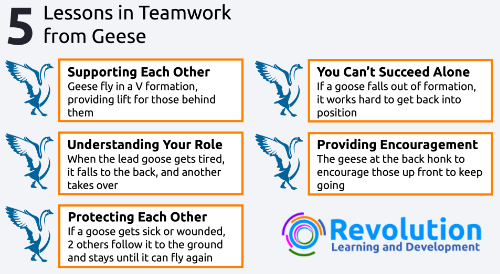[toc]
Teamwork and Geese
Geese demonstrate some great examples of teamwork. They show some simple but highly effective teamwork principles that we can use in both our business and personal life.
Geese work well as a team to achieve a common goal. They work together to help and support each other and these principles provide the basis of a highly effective team.
They show us 5 principles or lessons for effective teamwork.

The 5 Teamwork Lessons from Geese
Leeson 1 – Supporting Each Other
When geese fly they fly in a V formation. As each goose flaps its wings it provides uplift for the geese that are behind making it easier for them to fly longer distances.
This shows us that people who have a common goal and a sense of belonging get reach their goals faster and easier because they are all providing help and support to each other.
Lesson 2 – You Can’t Succeed Alone
When a goose falls out of formation it feels the drag as it is no longer feeling the benefit of the lift described in lesson one. It works hard to get back into the formation to get the full benefit once again and rejoin the group.
This shows that if we try to fly alone we won’t feel the support of the rest of the team. If we do fall out of formation we should do all we can to get back.
Lesson 3 – Understanding Your Role
When the lead goose gets tired it moves to the back of the formation and another goose takes over the lead.
This shows us that good teams understand that it pays to take turns at the harder tasks and sharing the lead.
Lesson 4 – Encouragement
The geese following the lead honk to encourage those in front to maintain the speed and work rate.
This shows us that a team needs to encourage each other to achieve and keep going. Our ‘honking’ should be useful though and not something that discourages or damages the team.
Lesson 5 – Protecting Each Other
If a goose gets sick or wounded, two geese drop out of the formation and follow the bird to the ground. They do this to provide protection. They stay with that member until they are well enough to fly again or dies. They then head out on their own or join another formation or catch up with their own flock.
This shows us that a team stands by each other. They support the ‘weaker members’ and stand by them through difficult times. They help people to get back on their feet.
Does your team perform as well as geese?
Effective Team Working Training Course
If you would like to learn more about teamwork and building effective teams, take a look at our Building High Performing Teams Training Course where you will find lots of hints, tips and ideas.




